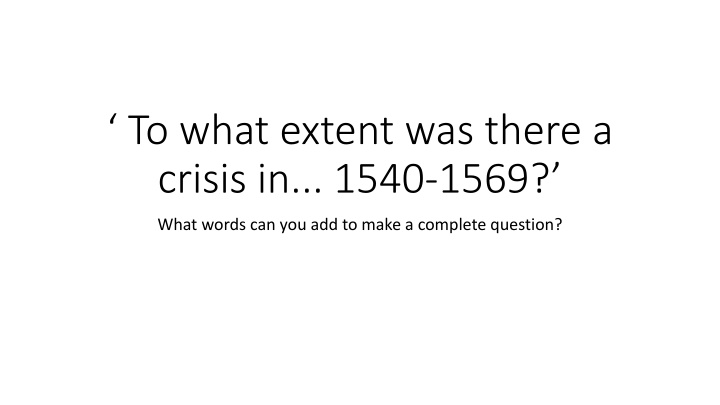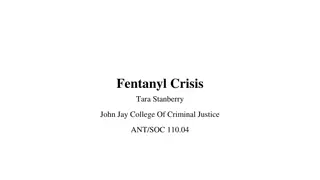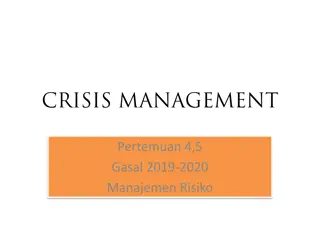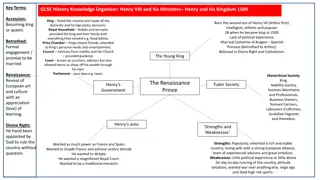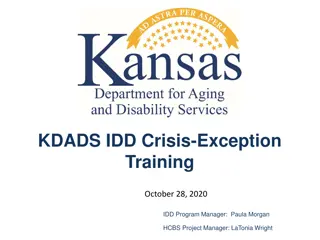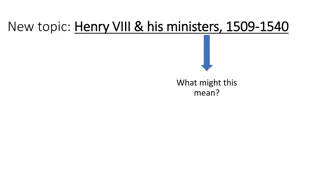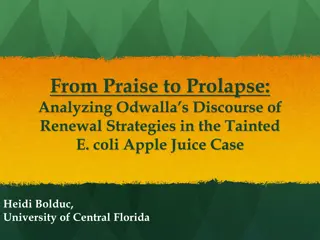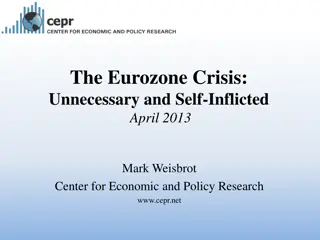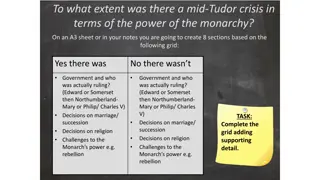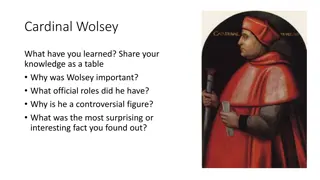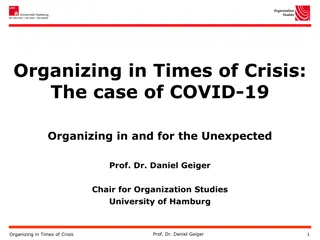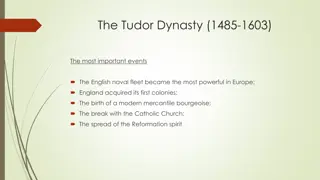Mid-Tudor Crisis: A Comprehensive Overview
The period from 1540 to 1569 marked a tumultuous time in Tudor history, characterized by political instability, economic challenges, religious turmoil, and societal shifts. Key questions surrounding the crisis include the extent of royal authority restoration, governance effectiveness, foreign relations, social and economic changes, intellectual and religious shifts, and the role of key individuals. This era saw a population increase, inflation, enclosure practices, and shifts in farming practices, all contributing to a complex mid-Tudor landscape. Learn about the main arguments supporting and opposing the notion of a mid-Tudor crisis.
Download Presentation

Please find below an Image/Link to download the presentation.
The content on the website is provided AS IS for your information and personal use only. It may not be sold, licensed, or shared on other websites without obtaining consent from the author.If you encounter any issues during the download, it is possible that the publisher has removed the file from their server.
You are allowed to download the files provided on this website for personal or commercial use, subject to the condition that they are used lawfully. All files are the property of their respective owners.
The content on the website is provided AS IS for your information and personal use only. It may not be sold, licensed, or shared on other websites without obtaining consent from the author.
E N D
Presentation Transcript
To what extent was there a crisis in... 1540-1569? What words can you add to make a complete question?
The 6 key Tudor Questions The 6 key Tudor Questions 1. How effectively did the Tudors restore and develop the powers of monarchy? Links to lack of royal authority in this period, factionalism 2. In what ways and how effectively was England governed during this period? As above, plus government mistakes that led to rebellion/discontent in local areas 3. How did relations with foreign powers change and how was the succession secured? Foreign policy success but at great cost with detrimental economic effects. Succession a BIG problem under Edward and Mary
The 6 key Tudor Questions The 6 key Tudor Questions 4. How did English society and economy change and with what effects? Economic hardship, inflation, enclosure etc. This also links to rebellions (e.g. Kett s, Western) 5. How far did intellectual and religious ideas change and develop and with what effects? This one should be obvious! 6. How important was the role of key individuals and groups and how were they affected by developments? Impact/role of reformers and conservatives. All sorts of possible key individuals involved!
Tudor government Most of the important decisions were taken by the monarch and a small group of advisers (the Privy Council) Statutes (laws) had to be passed by Parliament, but Parliament did not meet all the time Parliament met when called by the monarch The government could influence which MPs were chosen.
Tudor society Population increase. 2.3 million in 1500 to 3 million in 1547 Increase in demand for goods (e.g. food) led to inflation Higher population meant wages dropped and rents were raised Shift from grain farming (tillage) towards sheep and cattle farming (for wool and leather). This meant less food was produced, and it was more expensive Enclosure leads to poverty and tensions Increased migration to towns
Learning objectives Be able to explain the phrase mid- Tudor crisis Know the main arguments that support the view that there was a mid-Tudor crisis Know the main arguments against
Mid Tudor Crisis Traditional View
What is the Mid- Tudor Crisis theory? English government and society were on the verge of collapse. This was the result of weak rulers, economic pressure, rebellions, and religious upheaval. Although there was no collapse, this was an unproductive period of government. Also, these reigns are far less important than those of Henry VIII (earlier part) and Elizabeth I s golden years
Weak rulers: Why? Weak rulers: Why? In his later years, Henry was chronically unwell. Access to the King was controlled by Anthony Denny, a key member of the Reform faction Edward VI was merely the pawn of Somerset and Northumberland Somerset genuinely cared about the people of England, but was a poor politician; his policies were a major cause of the 1549 rebellions Northumberland was a better politician, but his policies were morally questionable, and benefitted the rich at the expense of the poor Mary I was intolerant and dogmatic; this was demonstrated by the burning of heretics. She appeared to be controlled by Philip. Elizabeth was young and inexperienced.
Economic problems: What? Economic problems: What? Real wages fell by as much as 60% in this period, (a time when 80% of the average worker's wages were spent on food.) Debasement of the coinage to pay for foreign wars, and population growth were the major causes of economic problems
Rebellions: Can you name them? What caused Rebellions: Can you name them? What caused them? them? The Western Rebellion of 1549 was largely a reaction to Somerset s religious reforms. Could the government be blamed for this rebellion? Kett s Rebellion of the same year was caused by economic factors. Could the government be blamed for this rebellion? Wyatt s Rebellion can be traced to Mary s marriage to Philip, among other factors. What does this suggest about Mary? The Northern Rebellion was partly religious and partly in response to Elizabeth s mishandling of the Northern Earls. Could the government be blamed for this rebellion? How effectively were the rebellions handled?
Faction fighting and unstable government Faction fighting and unstable government Henry s later years were dominated by factional struggles (Conservatives vs Reformers) Somerset came to power after a power struggle between conservative and radical elements within Henry s government. Despite the execution of his brother, Somerset continued to be the victim of faction fighting, ultimately leading to the rise of Northumberland Northumberland himself had to quell an attempted coup by Somerset Mary had a large privy council (prone to factionalism) Mary s marriage to Philip was unpopular and divisive
Foreign Policy Failures Foreign Policy Failures Rough wooing in Scotland. Successful in military terms, but huge impact economically. Ditto France campaign under Henry VIII Somerset s war with Scotland= unsuccessful; it was ended by Northumberland This war also led to economic problems within England as well as social unrest Mary s war with France (supporting Philip and the Spanish) led to loss of Calais and debt
Local Grievances Local Grievances A vacuum of power in local politics allowed local problems to grow. The demands of Kett s and Wyatt s Rebellions are evidence of unsolved local issues growing into significant uprisings. The Northern Rebellion is evidence of discontent at central government policies and of Elizabeth s mishandling of the Northern nobility
Religious Upheaval Religious Upheaval This was a period of huge religious change, including the moderate Protestant reform of Somerset, the radical Protestant reform of Northumberland, and the return to traditional Catholicism under Mary followed by a moderate(but controversial) settlement under Elizabeth Religious reforms significant in the Western Rebellion, Wyatt s Rebellion and the Northern Rebellion
Succession Crisis Succession Crisis Northumberland s attempt at altering the succession angered not only Mary s Catholic supporters but also others who accepted Mary as the rightful heir This was unsuccessful but led to further instability at the heart of government
Reasons why the crisis theory has been popular 1. H s and Eliz s reigns saw lasting change e.g. break with Rome. English official church is Church of England. 2. Elizabeth s defeat of Spain appealed to historians writing during the British Empire 3. C of E = part of English culture in Victorian times. Mary s reign seemed foreign . 4. Popularity of Foxe s book of martyrs- reinforced Bloody Mary image. 5. Films and TV focus on dramatic events of H s and E s reigns.
How would you government? Come up with a list of possible indications that a country is in crisis. you define a crisis in
Revisionists argue there was no crisis based on the following key points. What evidence is there to support each point? 1. Crisis is an exaggeration 2. Strength of the State 3. Continuity in Government 4. Comparisons with other periods 5. The 4 Rebellions were not a major threat 6. Economic Problems have been exaggerated 7. Strengths of the Rulers Discuss briefly you might not have evidence for all of them.
Loades The true significance of the reigns of Edward and Mary lies less in what happened than in what did not happen . What does he mean by this? Parliament not destroyed Royal supremacy intact England s independence not lost No faction-driven civil wars
N. Heard At no time, even in 1549, was the country in danger of collapse, and for most people life went on as normal. How far do you agree with this?
1. Based on your opinion of what constitutes a crisis, are the revisionists right to suggest that this was not a crisis? 2. If it is true that the situation was worse in other periods, does this prove there was no crisis in Mid-Tudor times? 3. If the situation was no worse than in other periods of time, why does it seem worse under Edward and Mary? 4. Do you agree that Somerset, Northumberland and Mary ruled effectively?
Post-revisionists Revisionists have gone too far in downplaying the problems faced in this period, in several key areas: SOCIAL AND ECONOMIC England was facing severe economic hardship. Even accepting the mitigating factors offered by the revisionists, the "big fact" is that 80% of wages were spent on food during this time, but that those wages were 60% less in 1559 than 50 years earlier. Compounded with consecutive harvest failures following heavy rains in 1556 and 1557, and an outbreak of sweating sickness in 1551 and 1552, the commons were facing a traumatic situation. The epidemics of 1556 and 1558 reduced the population by 200,000 (6%), with the death rate at twice its normal level.
Matusiak 4. This period was one of constant religious uncertainty, with England vacillating between moderate and radical Protestantism and reactionary Catholicism within the space of two decades. In addition, the loss of Calais and Bolougne in particular damaged English national pride and contrast with the relatively successful ventures of Henry VIII. The fact that Parliament had to be dissolved in 1549, 1550, 1552 and 1553 demonstrates the instability faced at the upper echelons of government.
Matusiak While the problems were by no means unique in the Tudor period, the conjuncture of all of them within the space of 25 years was unique, and made the period particularly volatile. He argues that this period was no crisis because the essential state machinery was not under threat, but that it was a time of trauma during which the state's efforts were focused on survival rather than achievement.
Was there a mid-Tudor crisis? Questions to discuss. How would you define crisis? In what ways were these years of crisis? Were the problems they faced of their own making? Was Mary more successful than Edward or vice versa? Were they successful/unsuccessful in the same areas? How far could they be seen to be unlucky rather than incompetent? Which historian do you agree with most and why? Which historian do you disagree with most and why?
